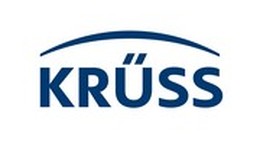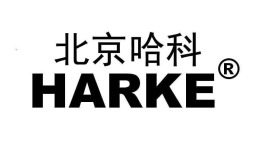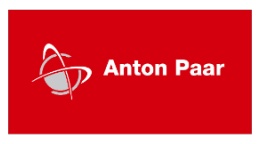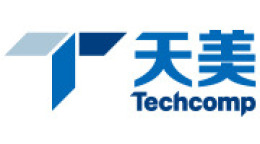方案详情文
智能文字提取功能测试中
KRUSS Application Report Surface Energy Characterization and Adhesion Properties of High ViscosityInk Pastes IAbstract Printing processes, such as lithography, are greatly affected by surface properties such as surface and interfacial tension,surface energy, and adhesion. Efficient uptake, transport, and adhesion of ink pastes onto various surfaces are governedby surface energy, given by the polar and dispersive properties of both substrates. The lithographic process utilizes printplates designed to have print and non-print surfaces. Fountain solutions are used for the purpose of blocking the non-print surfaces from accepting ink. The print surfaces of the plate are expected to accept ink and transfer it to a "blanket,"or rubber roller, which transfers the ink onto paper or other substrate. To study these types of surface interactions,liquidsare typically characterized by classical methods of DuNouy Ring or Wilhelmy plate. However, in this study, two ink pastesare characterized by treating the samples as solid surfaces, using the Fowkes two-component method of surface freeenergy, and adhesion properties of the inks to several surfaces are discussed. Experimental section Two ink pastes from an ink manufacturing company werestudied: INK A,which showed very goodladhesionproperties in application, and INK B, which was nottransferring properly to the print blanket, thus causingpoor print quality. The inks were characterized for overallsurface energy and surface polarity in both the originalinks, and when emulsified with 15 wt% of fountainsolution. Emulsions of the pastes and fountain solutionswere studied because they contact one another in theprinting process, and it is known that the fountainsolution will act to emulsify the paste. As neither theoriginal paste, nor the emulsified pastes were of lowenough viscosity to be tested as liquids, the sampleswere tested for surface energy as solid surfaces. Glassslides were separately coated with both the pastes andemulsions, and contact angles were obtained with theKruss Drop Shape Analysis System DSA10.Results showthe average of five drops of both diiodomethane andwater on the samples (see table 1). Ink Paste Contact Angle withWater (degrees) Contact Angle withDiiodomethane (degrees) A 92.6 43.5 B 90.4 61.8 Table 1: Contact angle with water and diiodomethane on inkpastes Contact angles with diiodomethane and water afteremulsifying each paste with 15 wt% of fountain solutionare shown in table 2. Ink Emulsion Contact Angle withWater (degrees) Contact Angle withDiiodomethane (degrees) A (emulsion) 87.0 44.6 B (emulsion) 81.0 62.0 Table 2: Contact angle with water and diiodomethane on inkemulsions The Fowkes two-component method (see ApplicationNote 306, "So You Want to Measure Surface Energy,"www.kruss.de) of solid surface energy was aapplied,yielding the following surface energy values of both theoriginal and emulsified pastes (see table 3). Paste OverallSurfaceEnergy (mJ/m) Polar Component (mJ/m²) DispersiveComponent (mJ/m²) SurfacePolarity(%) A 38.02 0.21 37.81 0.56 B 29.36 1.82 27.54 6.19 A (Emulsion) 38.27 1.04 37.23 2.72 B (Emulsion) 32.39 4.97 27.42 15.34 Table 3: Surface energy values of both the original andemulsified pastes Results from the original inks show two major differencesin their surface properties: The overall surface tension of INK B is lower than that ofINK A. This implies that INK B may wet surfaces moreeasily than A. However, INK A has a much lower surfacepolarity (0.56%) than that of INK B (6.19 %). So thoughINK B may appear to wet better, it actually will not"adhere" as well as INK A to low polarity (hydrophobic orlipophilic) surfaces - such as print blankets. When 15 wt% of the fountain solutionwere mixed withthe original ink pastes, both emulsions showed increasesin overall surface energy, though the Emulsion B increasewas more significant. However, differences in surfacepolarity were much more extenuated in the emulsionsamples. Both inks show increases, but customer INK Ashowed a dramatic 9 % increase in surface polarity.Results show that the wetting properties of the two inksbecome more similar by the addition of the fountainsolution, while their relative abilities to adhere to lowpolarity surfaces become more separated. To better understand why the diluted fountain solutionwere having such effects on the surface properties of thetwo ink pastes, the overall surface tension, with polar anddispersive components, was tested using the Wilhelmyplate method on a Kruss Force Tensiometer-K100.Measurements of the liquid againstpoly(tetrafluoroethylene) yielded the polar and dispersivecomponents of the overall surface tension by applyingthe Fowkes equation to the contact angle results. Theaverage of duplicate experiments is shown in table4. Surface Tension Data for Diluted Fountain Solution (29.96 kg/m) Test # OverallSurface Tension(mN/m) ContactAngleon PTFE(degrees) Dispersi veComponent(mJ/m²) PolarComponent(mJ/m²) Surfac ePolarity(%) Average 38.46 79.5 28.71 9.75 25.35 Table 4: Surface tension data for diluted fountain solution First, the fact that the overall surface tension of thediluted fountain solution is 38.46mN/m explains whyadding it to the A paste (original surface energy =38.03 mN/m) only increases its surface energy slightly,whileadding it to the B paste (original surface energy =29.36 mN/m) increases the B paste's surface energy moresignificantly. Second, the fact that the surface polarity ofthe fountain solution, which adheres to the non-printsurfaces to prevent paste from adhering to these spots, isonly 25.35 %suggests that the emulsified B paste (at15.34 %) may have problems staying only on the printsurfaces. This study also included surface energy characterizationwith polar and dispersive components of four surfaces(print surface, non-print surface, new blanket, and usedblanket) for comparison between INK Aand INKBadhesion usingthe Fowkes/Dupiprree expression(seetable 5). Surface OverallSurfaceEnergy(mJ/m) PolarComponent(mJ/m) DispersiveComponent(mJ/m) SurfacePolarity(%) PrintSurface 42.26 1.61 40.65 3.81 Non-PrintSurface 69.82 42.57 27.25 60.97 New Blanket 14.14 0.08 14.06 0.54 UsedBlanket 35.66 4.15 31.51 11.65 Table 5: Surface energy values on printing plate on blanket Results show that Paste A and Emulsion A should (anddo) adhere best to the print surface because the polarityof the ink and the print surface match more closely(0.55 and 2.72 %for INK A versus 6.2 and 15.34 %for theproblematic INK B), and likewise yield higher adhesionenergies using Fowkes/Dupre theory (see table 6). Adhesion Energy Values in mJ/m2 Print Surface Non-PrintSurface NewBlanket UsedBlanket A 79.57 70.18 46.37 70.89 B 70.34 72.39 40.11 64.41 A (emulsion) 80.39 77.01 46.33 72.65 B (emulsion) 72.43 83.76 40.51 67.87 Fountain Solution 76.25 96.69 41.92 72.88 Table 6: Adhesion energy values The non-print surfaces should not present problemsbecause the pastes and emulsions have little chance todisplace the fountain solution from the non-print areadue to its high polarity (60.97%). The adhesion energybetween the non-print area and the fountain solution ismuch1 greater than betweenany of the pastes oremulsions and the non-print surface. The new blanket was studied which was extremely low inoverall surface energy (14.14 mJ/m²) and surface polarity (0.54%). Therefore,adhesion to the blanket is going to be best for a lowsurface polarity, high overall surface tension liquid. Asexpected, the overall surface polarity of the blanketmatched best the surface polarity of the competitor ink;hence the better observed printing results. The used blanket’s performance is expected to decreasewith use because the surface appears to become muchmore polar, and higher in overall surface energy, withuse. Overall, the surface polarity of the customer's INK A washigh compared to their competitor. It was concluded thatthe problematic ink needed to be reformulated todecrease surface polarity and increase overall surfacetension for better adhesion performance. Thesurfacepropertiesof twolOink pastes werecharacterized to understand their performance on severaldifferent surfaces. Because of the high viscosity of thepastes, a different approach was developed to study thesurface energy components by treating the samples asthough they were solids, and applying the Fowkes two-component surface energy method to observed contactangles. Results confirmed what the customer wasobserving: that one ink was performing better than theother, and, more importantly, served as a directionalrecommendation on how their particular formulationcould be altered to improve performance. KRUSS GmbH|Borsteler Chaussee Hamburg|Germany|www.kruss.de|
关闭-
1/3
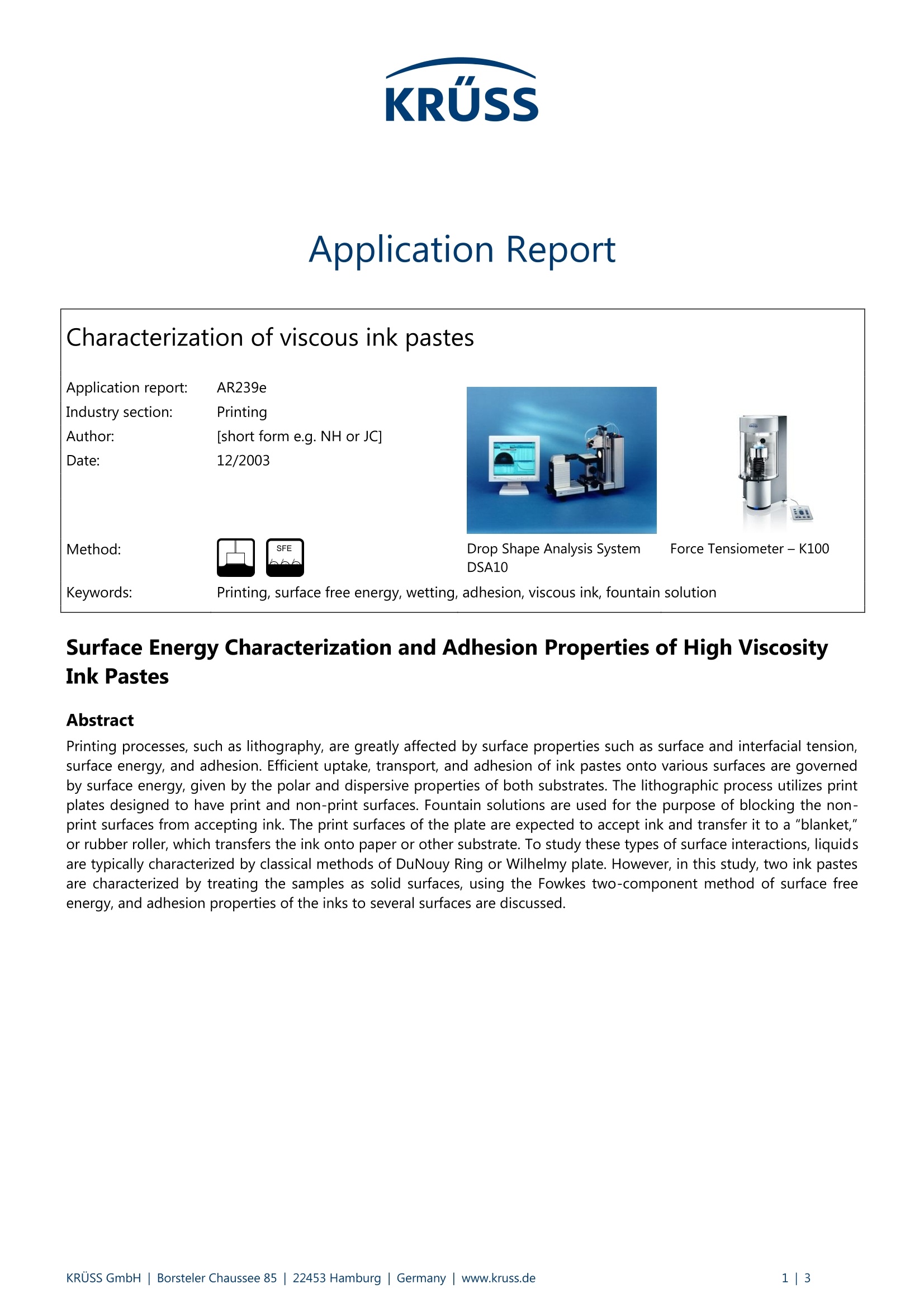
-
2/3
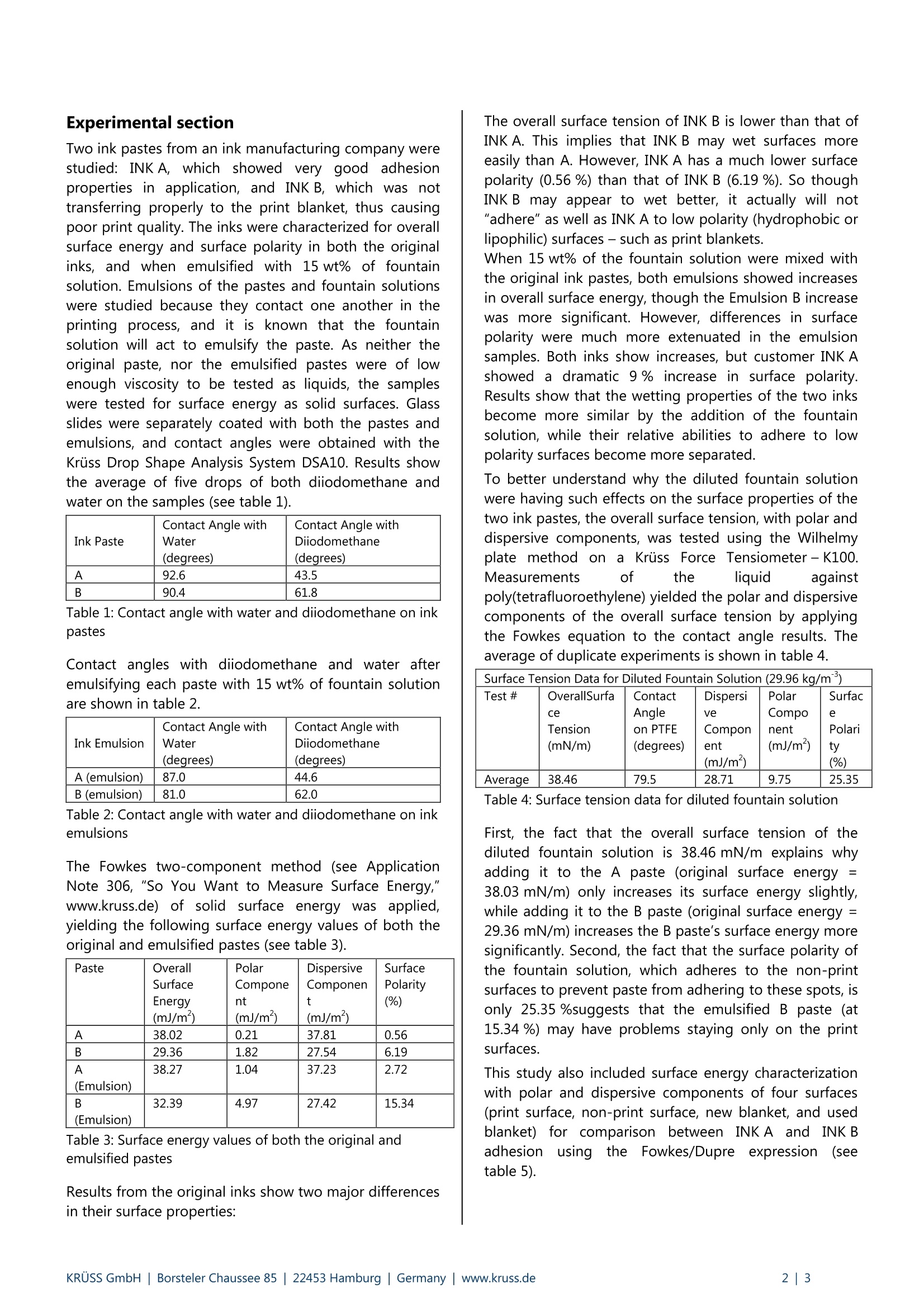
还剩1页未读,是否继续阅读?
继续免费阅读全文产品配置单
克吕士科学仪器(上海)有限公司为您提供《油墨中表面能检测方案(接触角测量仪)》,该方案主要用于油墨中表面能检测,参考标准《暂无》,《油墨中表面能检测方案(接触角测量仪)》用到的仪器有KRUSS DSA100接触角测量仪。
我要纠错
相关方案


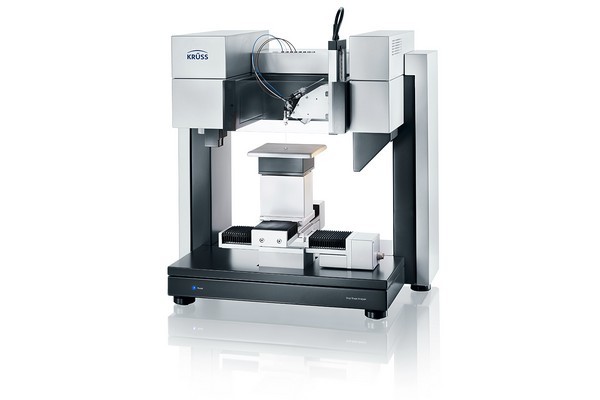
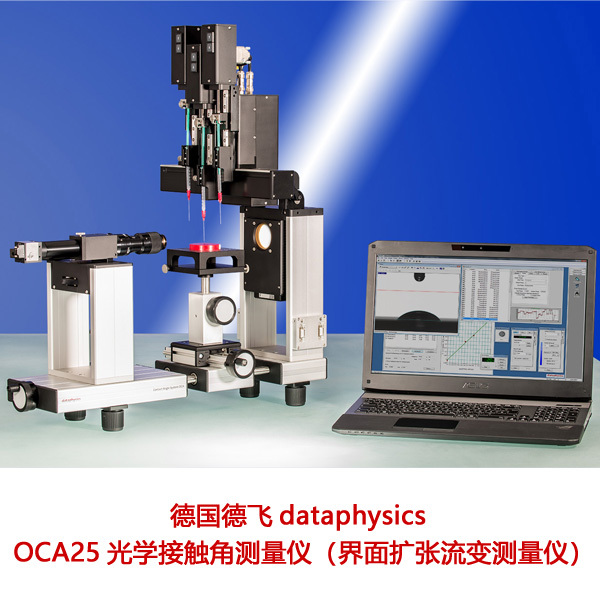
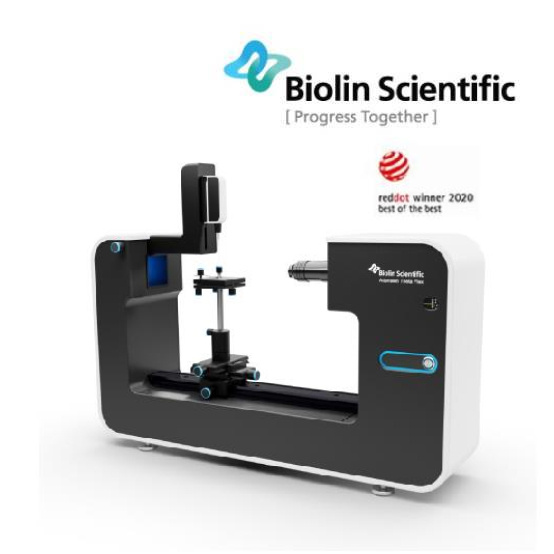
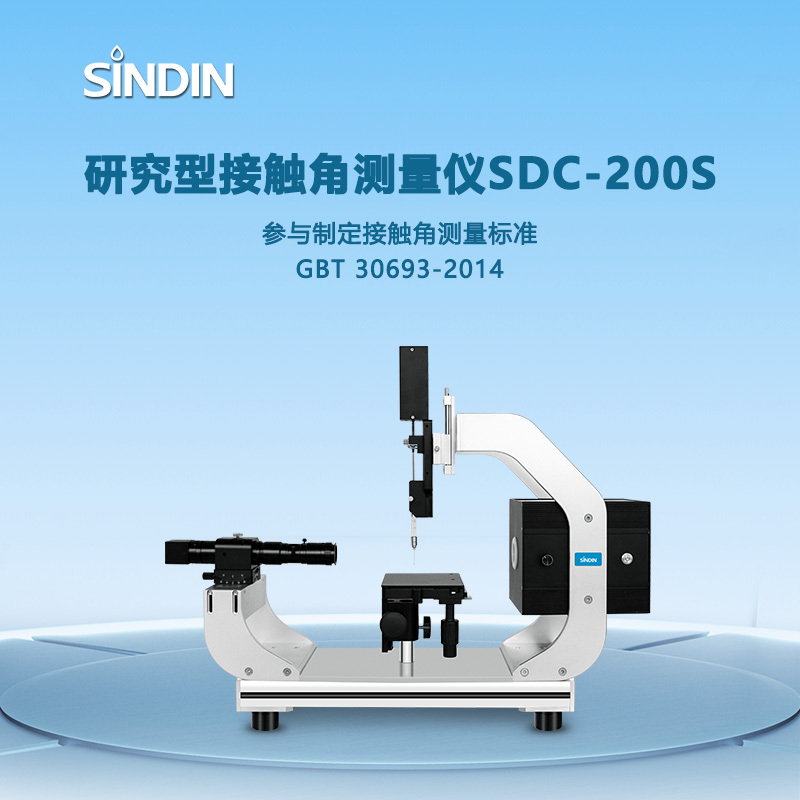
 咨询
咨询